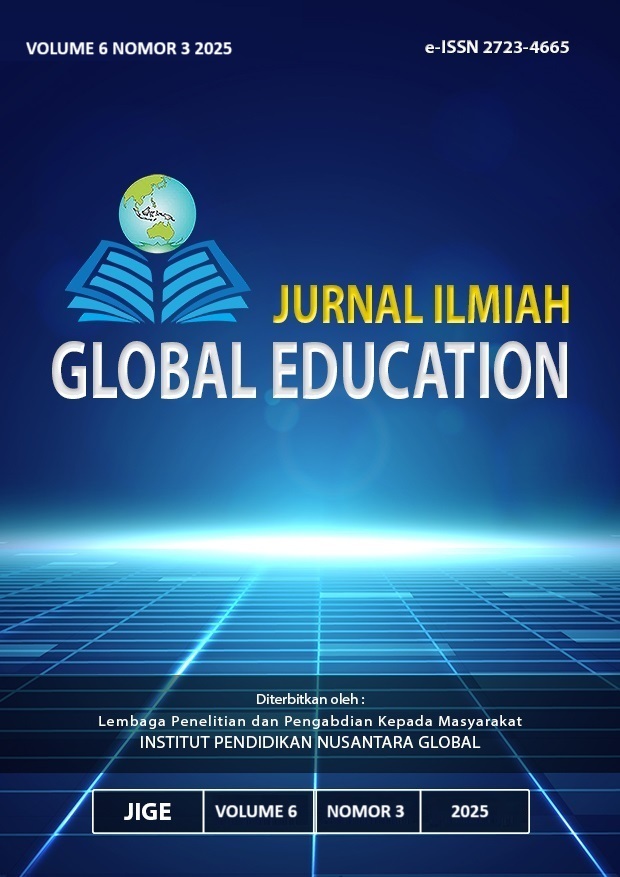The Role of Family Background of Speaking Skill: A Comparison between Public and Private School Students
DOI:
https://doi.org/10.55681/jige.v6i3.4011Keywords:
Family Background, Speaking Skill, Public and Private SchoolsAbstract
This study compared eighth-grade students from Tanjungpinang's SMPN 7 (a public school) and SMP Muhammadiyah (a private school) during the 2024–2025 school year in order to examine the impact of family background on students' English-speaking abilities. 60 students' responses to structured questionnaires and speaking assessments were gathered using a quantitative comparative design. A rubric measuring fluency, accuracy, pronunciation, vocabulary, and coherence was used to evaluate speaking performance, and questionnaires examined parental education, income, home language environment, and English learning support. Students attending private schools typically came from families with higher socioeconomic status and educational attainment, according to descriptive statistics. With notable improvements in pronunciation and fluency, these students also performed better in speaking than their peers in public schools. Speaking scores for the two groups differed significantly, according to inferential analysis using an independent sample t-test. Additionally, correlation analysis showed that students' speaking abilities and family background factors specifically, parental education and the frequency of English use at home were positively correlated. The results showed that students' oral English proficiency was significantly shaped by their family background, and that this influence was stronger for students attending public schools with fewer institutional resources. In order to promote equitable language learning opportunities, the study emphasized the combined effects of the home and school environments on language development and the necessity of cooperation between educators, parents, and legislators.
Downloads
References
Aeni, N., & Limbong, S. (2023). The investigation of constraints faced by parents in introducing English to young learners: A descriptive study. _ENGLISH FRANCA: Academic Journal of English Language and Education, 7*(2), 327–334. Retrieved from https://journal.iaincurup.ac.id/index.php/english/article/download/8416/pdf/30784
Alias, N. Z., & Kamal, S. S. L. A. (2023). Factors influencing parental involvement in children's English as a second language learning: A case study of B40 and T20 families in Malaysia. MANU Jurnal Pusat Penataran Ilmu dan Bahasa, 35(1). https://doi.org/10.51200/manu.v35i1.5196
Astuti, R. (2017). Students’ difficulties in speaking English and factors influencing it. Journal of English Education, 5(1), 45–52.
Bachman, L. F., & Palmer, A. S. (1996). Language testing in practice: Designing and developing useful language tests. Oxford University Press.
Brown, H. D. (2004). Language assessment: Principles and classroom practices. Pearson Education.
Creswell, J. W. (2012). Educational research: Planning, conducting, and evaluating quantitative and qualitative research (4th ed.). Pearson Education.
Epstein, J. L. (2001). School, family, and community partnerships: Preparing educators and improving schools. Westview Press.
Eriksson, M., Marschik, P. B., Tulviste, T., Almgren, M., Pérez Pereira, M., Wehberg, S., Marjanovič Umek, L., Gayraud, F., Kovačević, M., & Gallego, C. (2012). Differences between girls and boys in emerging language skills: Evidence from 10 language communities. British Journal of Developmental Psychology, 30(2), 326–343.
Etikan, I., Musa, S. A., & Alkassim, R. S. (2016). Comparison of convenience sampling and purposive sampling. American Journal of Theoretical and Applied Statistics, 5(1), 1–4.
Fernald, A., Marchman, V. A., & Weisleder, A. (2013). SES differences in language processing skill and vocabulary are evident at 18 months. Developmental Science, 16(2), 234–248.
Fitriana, R. (2019). A comparative study of English speaking skills between private and public school students. Universitas Islam Negeri Walisongo, Semarang, Indonesia.
Halommi, L., & Stevens, J. (2023). Quantifying the relationship between parental involvement and English language proficiency among EFL learners. Research Studies in English Language Teaching and Learning, 1(4), 192–203. https://doi.org/10.62583/rseltl.v1i4.21
Harmer, J. (2007). The practice of English language teaching (4th ed.). Pearson Longman.
Hart, B., & Risley, T. R. (1995). Meaningful differences in the everyday experience of young American children. Paul H. Brookes Publishing.
Hendajany, N. (2016). The effectiveness of public vs private schools in Indonesia: Evidence from national exit exam scores. Journal of Indonesian Applied Economics, 6(1), 66–89. Retrieved from https://www.researchgate.net/publication/311957284_
THE_EFFECTIVENESS_OF_PUBLIC_VS_PRIVATE_SCHOOLS_IN_INDONESIA
Hoover-Dempsey, K. V., & Sandler, H. M. (2005). Final performance report for OERI Grant # R305T010673: The social context of parental involvement. Vanderbilt University.
Horwitz, E. K. (2001). Language anxiety and achievement. Annual Review of Applied Linguistics, 21, 112–126. https://doi.org/10.1017/S0267190501000071
Krashen, S. D. (1985). The input hypothesis: Issues and implications. Longman.
Luoma, S. (2004). Assessing speaking. Cambridge University Press.
Nabwire, C. E., Orago, S., & Nthiga, P. (2021). A Comparative Study of English Language Speaking Skill in Private and Public Primary Schools in Trans‑Nzoia County, Kenya. African Journal of Emerging Issues, 3(1), 191–204. Retrieved from http://ir-library.ku.ac.ke/handle/123456789/21969*
Padilla, A. M., & González, R. (2001). Academic performance of immigrant and U.S.-born Mexican heritage students: Effects of schooling in Mexico and bilingual/English language instruction. American Educational Research Journal, 38(3), 727–742.
Pasaribu, G. R. (2021). The role of parents in early children’s language development. Jurnal Pendidikan Bahasa dan Sastra, 1(2), 88–97. Retrieved from https://www.researchgate.net/publication/364262742_THE_ROLE_OF_PARENTS_IN_EARLY_CHILDREN%27S_LANGUAGE_DEVELOPMENT
Richards, J. C. (2008). Teaching listening and speaking: From theory to practice. Cambridge University Press.
Snow, C. E., Burns, M. S., & Griffin, P. (1998). Preventing reading difficulties in young children. National Academies Press.
Sumanti, C. T., & Muljani, R. (2023). Parents’ involvement and its effects on English young learners’ self-efficacy. Celtic: A Journal of Culture, English Language Teaching, Literature and Linguistics, 8(1). https://doi.org/10.22219/celtic.v8i1.14632
Sun, H., Ng, S. C., O’Brien, B. A., & Fritzsche, T. (2020). Child, family, and school factors in bilingual preschoolers’ vocabulary development in heritage languages. Journal of Child Language, 47(4), 817–843. Retrieved from https://www.researchgate.net/publication/339457718_Child_family_and_school_factors_in_bilingual_preschoolers%27_vocabulary_development_in_heritage_languages
Suryadarma, D., Suryahadi, A., Sumarto, S., & Rogers, H. (2006). Improving student performance in public primary schools in developing countries: Evidence from Indonesia. Education Economics, 14(4), 401–429.
Tomlinson, C. A. (2001). How to differentiate instruction in mixed-ability classrooms (2nd ed.). ASCD.
Vygotsky, L. S. (1978). Mind in society: The development of higher psychological processes. Harvard University Press
Downloads
Published
How to Cite
Issue
Section
License
Copyright (c) 2025 Nanda Kristia Santoso, Jamilah, Dyah Setyowati Ciptaningrum, Risgar Friassantano, Marina Lidya

This work is licensed under a Creative Commons Attribution-ShareAlike 4.0 International License.












